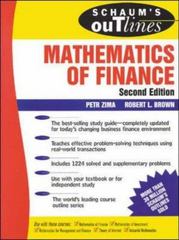Answered step by step
Verified Expert Solution
Question
1 Approved Answer
INTRODUCTION a ) I live freely and unmarried in Canada at the moment. b ) My journey as a software developer is about to commence.
INTRODUCTION
a I live freely and unmarried in Canada at the moment.
b My journey as a software developer is about to commence. My goal is to succeed in this industry and advance to a position of senior leadership. I expect to make a gross yearly income of $ based on my qualifications and industry standards.
SMART GOALS
ShortTerm Objective: Save $ for an emergency fund to meet unforeseen costs within two years.
MidTerm Objective: Save $ for a down payment on a property within five years.
LongTerm Objective: After years, retire at age with a comfortable $ yearly income that has been adjusted for inflation.
Retirement Goal: Assuming an average annual investment return of save $ million by the time you are
Financial Statements
Cash Flow Statement
Monthly Income
Gross Salary $
Total Income $
Monthly Expenses
Rent $
Utilities $
Groceries $
Transportation $
Entertainment $
Savings $
Loan Repayment $
Miscellaneous $
Total Expenses $
Net Cash Flow $
Balance Sheet
Assets Liabilities
Savings $ Student Loan $
Retirement Savings $
Home Equity $
Total Assets $ Total Liabilities $
Net Worth $
BUDGET REFLECTION
The estimated net cash flow suggests that I will be able to reach my financial objectives. But, in order to make sure I stay on course, I must constantly review and modify my budget.
Strategies to Reduce expenses
Limit your eating out and nonessential shopping.
To cut down on transportation expenses, choose carpooling or public transit.
Ask service providers to lower their prices.
Cash for Emergencies
My goal is to accumulate an emergency fund that covers six months' worth of living expenses. This will serve as a safety net in case of unforeseen financial difficulties.
Credit Management
My goal is to pay off my student loans as quickly as possible by setting aside a certain percentage of my monthly salary for debt payments. I'll also make an effort to keep my credit score high by making ontime bill payments and minimizing my credit card debt.
Planning Investments
With an emphasis on growth, my risk portfolio is somewhat aggressive. To attain diversification, my strategy involves distributing money among multiple asset classes, such as equities, bonds, and real estate investment trusts REITs Im going to assume a yearly average investment return.
Planning for Taxes
I will be in the marginal tax bracket based on my estimated income. I'll make the most contributions to taxadvantaged accounts, such RRSPs and TFSAs, in order to minimize taxes. Furthermore, I intend to leverage tax credits for qualified expenses and benefit from charitable donation tax deductions.
Insurance Strategy
My employer provides health insurance, which I think is sufficient for my needs. To guard against losing money due to illness or injury, I will think about getting more disability insurance.
Retirement Strategy
I will take advantage of employersponsored pension schemes and make regular contributions to retirement accounts like RRSPs in order to reach my retirement goal. In order to increase returns, I will think about making more contributions and changing my investing plan if I am not on track to meet my target.
Planning an Estate
To make sure my intentions are carried out in the event of incapacity or death, I will need to finish important documents including a living will, power of attorney, and will. I will look into methods like establishing trusts and donating assets while Im still living to reduce the cost of probate.
Outcomes
The financial statements I've been given give a clear picture of both my present and future financial circumstances. The strategy would be more understandable with graphs showing revenue, expenses, and net worth over time. Charts that contrast various investment options and their possible returns may also be useful in making decisions.
In conclusion, my financial objectives, plans, and projections for achieving financial stability and prosperity in Canada are detailed in this extensive personal financial plan. To guarantee congruence with changing objectives and shifting economic circumstances, regular monitoring and modifications will be essential.
Plot a histogram for the financial plan above
Step by Step Solution
There are 3 Steps involved in it
Step: 1

Get Instant Access to Expert-Tailored Solutions
See step-by-step solutions with expert insights and AI powered tools for academic success
Step: 2

Step: 3

Ace Your Homework with AI
Get the answers you need in no time with our AI-driven, step-by-step assistance
Get Started


